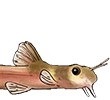Article © Lee Finley, uploaded January 01, 2002.
Pimelodid hybrids have caused a great deal of confusion among aquarists. These fish are spawned, artificially under laboratory conditions, for use in aquaculture. A few have made their way into the aquarium fish trade. The main amount of work in this area that I have come across is being reported by Venezuelan aquaculture investigators. Following is a listing of the genera crosses that have been reported in the literature. There may be others, but this is what I currently have available in my library:
- Perrunichthys x Sorubim
- Perrunichthys x Pseudoplatystoma
- Pimelodus x Leiarius
- Pimelodus x Pseudoplatystoma
- Pimelodus x Phractocephalus
- Pimelodus x Sorubim
- Pseudoplatystoma x Phractocephalus
- Perrunichthys x Leiarius
- Pseudoplatystoma x Leiarius
- Phractocephalus x Leiarius
Prior to the work on the above genera, the two main phylogenetic layouts of the larger pimelodids placed some of the hybridized genera at distal ends of their trees. I can do no better here that to quote from one of the papers, " This hybrid [ P. fasciatum x L. marmoratus ] between two taxa that are supposed to be only distantly related in the schemes proposed by Lundberg et al (1991) and Nass (1992) open a new unexpected range of possibilities for fish culture using these valuable catfish, which are in high demand in South America."
That some of these crosses (bastards, if you will) have made their way into the hobby (at generally outrageous prices, I might add) is without question. Hopefully this trend will not continue. For those who like the larger pimelodids, there are many great ones available and we don't need these "mutts" in the hobby. All, please try to discourage your local fish stores from stocking these animals. In regards to fish shows, they should (in my opinion) be given the same treatment that the American Cichlid Association gives to cichlid hybrids - NOT ALLOWED! Let these fish be what they are intended for namely food supply.
One last personal thought: Although there doesn't appear to be information available on the potential reproductive viability of these hybrids, I am somewhat concerned in regards to what might happen should large numbers of some of these captive aquacultured fishes escape into the environment and "mingle" with wild pimelodids. This could potentially create a real gene pool disaster with existing wild stocks should the fishes be viable.
For those that might be interested, I will offer the following short list of resources. I will not pretend that it is complete...it is only what is currently present in my library. I will note that some of the articles do contain interesting photos of some of the hybrids which might be of use to show committee members.
- Jose Quero V. and Kossowski, C. 1993. Cariotipos del hibrido de Pseudoplatystoma fasciatum (Linnaeus) 1766 (hembra) por Leiarius marmoratus (Gill) 1871 (macho) y sus especies progenitoras (Pisces, Siluriformes, Pimelodidae). Biollania 9:11-16.
- Castillo, O., Nass, P., and Kossowski, C. 1995. Analisis morfometrico multivariado del bagre yaque pintado, un hibrido artificial entre Pseudoplatystoma fasciatum y Leiarius marmoratus (Siluriformes, Pimelodidae). Biollania 11:13-26.
- Tome, E., Kodaira, M., and Cabrera, A. 1997. Estabilidad de hybridos de bagre Pseudoplatystoma fasciatum x Pimelodus blochii y Pseudoplatystoma fasciatum x Perrunichthys perruno almacenados en hielo. Acta Biol. Venez. 17(4):47-55.
There is further information on this species on the Cat-eLog page.
Back to Shane's World index.




